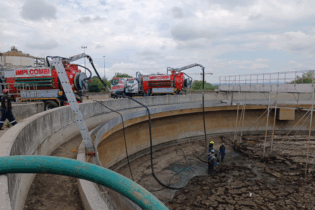For three decades, the Paper Manufacturers Association of South Africa (PAMSA) has been promoting the positive economic, environmental and social story of forest-based pulp and paper products. ReSource speaks to Jane Molony, executive director at PAMSA, about the importance of sustainable forestry and fibre production in the quest for a circular, zero-waste economy.
What is PAMSA’s focus?
JM Sustainability and circularity are our main goals. And our mission is to provide the sector with a voice on issues relating to the renewability and recyclability of wood-based or fibre products that we use every day for packaging, hygiene and communication. To this end, PAMSA represents more than 90% of pulp, paper, paper packaging and tissue manufacturers in the country. We have supported the pre-competitive interests of and issues affecting our members and the forestry sector at large by way of advocacy with government, especially in terms of environmental matters such as climate change, carbon tax, water, waste and energy. Another big area of focus is education and training, while our research and development efforts help support sustainability and diversification. PAMSA also manages RecyclePaperZA, which represents processors of recycled paper fibre. The forestry and fibre story is a great one, and so we aim to share it in any way we can, about how forest products are made, and how they make a difference.Many believe that the forestry and paper industry contributes to deforestation? Is this true?
This myth remains one of our biggest challenges! Our sector does not use indigenous trees for productive purposes, yet debunking the notions that industrial forestry is a destructive practice isn’t easy. The global forestry and forest products sector continues to tacklethese misconceptions. Many vilify the sector without understanding its circularity, its ability to store carbon and, crucially, how it helps to cut back on the use of fossil-fuel-based products. Deforestation, however, must be reduced in the context of indigenous or protected forests, and illegal
wood trade. Trees in plantations are essentially crops that are planted and replanted in rotations, with only about 9% of the total tree count being harvested in any given year. This means that there are always trees growing, at different stages of maturity, and these trees are all absorbing carbon dioxide (CO2) and storing the carbon. The fact that trees are planted, harvested and replanted on the same land makes wood and paper a renewable and efficient resource. For a low-carbon future, it’s tremendously exciting.
How does this circularity extend to other areas?
Beyond the harvesting and replanting, the circular economy extends to leaving forest residues in situ as a mulch for the next generation of trees. After harvesting, bark, limbs, leaves and small parts of the harvested trees are left on the forest floor, offering sustenance to the soil and refuge for creatures that aid in the decomposition of organic matter, which in turn attracts birds and animals. Biodiversity, conservation and wetland stewardship also form an integral part of the ecosystem of our sector. While plantations are monocultures, there is a mosaic of commercially farmed plantations and indigenous forests, wetlands, grasslands and natural corridors. It’s all about balance! At mill level, our members are continually looking at every aspect of their operations to reduce water use, energy consumption and air emissions. Pulp and paper mills operate in a closed-loop process, by using natural resources efficiently – often more than once. This is also where recycling of paper fibre comes in. As a sector, we use both virgin wood fibre and recovered paper fibre to make products. Some mills will use a combination of both; others are able to use only recovered paper. However, we will always need virgin fibre to keep the paper cycle going, as paper fibres do not have an infinite lifespan – although research from Graz University in Austria has found that paper fibre can be recycled up to 25 times! Process water is reused and recycled, lost fibre is recovered and reused, and spent chemicals are recovered for energy production. Even bark – a biomass – is used to power boilers, producing steam that generates electricity. This sees us using more of the tree, ensuring little goesto waste.
How does the forest products industry seek to promote a circular economy?
First, we need to increase uptake of wood products in traditional markets – timber in the built environment, shifting to functional paper packaging and driving the use of fibre present in everyday life (e.g. paper, tissue, packaging and cellulose products).Organisations like the Food and Agriculture Organisation (FAO) recognise wood as a viable substitute for carbon-intensive materials such as steel and concrete in construction, and plastic and textiles in everyday applications.
Also key is harnessing the potential of wood fibre and process waste in new applications, such as the use of lignin for batteries for electronics, or extracting sugars and hemicellulose for bio-based chemicals. And then, of course, we need to plant more trees to meet this demand.How will a bioeconomy approach revolutionise your sector?
A bioeconomy is circular by nature, relying on technological innovations aimed at substituting non-renewable resources with bio-based alternatives. Manufacturing sectors such as ours play a key role in terms of adding value, economic growth and green job creation through the supply of renewable raw material for construction, furniture and bioenergy. This takes mills beyond paper, and into the realms of a biorefinery. Using their inherent biorefinery technologies, mills can extract a range of components such as cellulose, lignin and sugars from process streams that would otherwise become process waste. For example, cellulose – the most abundant organic compound and polymer on earth – is the major component of wood and the starting point for various reactions. Dissolving wood pulp, a purified form of cellulose, is suitable for subsequent chemical conversion into a range of products. It is spun into viscose and lyocell textile fibres for use in fashion and decorating textiles, cast into a film, or regenerated into a sponge. Wood also gives us products such as carboxymethyl cellulose or microcrystalline cellulose. This fine powder is extremely versatile. It can bind active medicinal ingredients or vitamins into palatable tablets, stabilise emulsions or increase viscosity – which is why cellulose is added to low-fat yoghurt, and lipstick! It also acts as an abrasive or exfoliant in cosmetics, or an anti-caking agent in washing powders or foods. Additionally, nanocellulose – tiny cellulose nanofibres and nanocrystalline cellulose – can be used in wound dressings and surgical gels, food supplements and edible packaging, or even as a composite for screens on electronic devices. A substitute for diesel, bio-oils are obtained by heating wood in an oxygen-free environment, in a process known as pyrolysis. The solid product generated (bio-char) can be used as an enriched growing medium for seedlings or converted into high-grade activated carbon.Can we make a climate case for wood?
Yes, and we are shouting it from the rooftops. We stand firm in the fact that a holistic, sustainable and circular forest bioeconomy is essential to fighting climate change. We can probably assume that most people, when considering ways to fight climate change, don’t immediately think of forestry. But there is a unique climate case for sustainable wood – it is the only material that can naturally and significantly decarbonise our planet by driving down demand for illegally harvested wood, and provide functional alternatives to non-renewable materials that have significantly higher environmental footprints. The FAO Forest Resource Assessment 2015 states that world forests were sequestering close to 300 gigatonnes of carbon. Commercial forestry achieves this through both growing trees (absorbing CO2) and harvesting them at the right time, with carbon being stored in harvested wood products. Harvesting makes space for younger trees that take up more carbon dioxide than their older counterparts. The climate benefit is thus evident in two places: through a stable and increasing carbon storage in the forest itself, and in the forest products. Climate change is not caused by people in developing countries felling trees. Instead, it’s caused by high- and middle-income countries burning fossil fuels. We need to focus on displacing these fossil-derived emissions by using wood’s inherent power as theultimate renewable.








